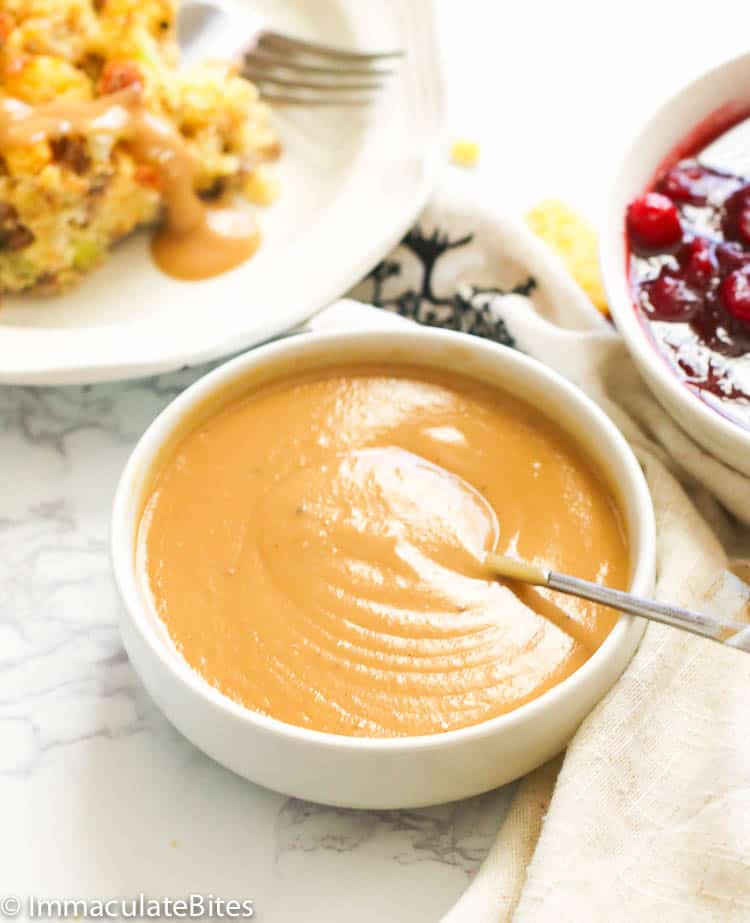Homemade gravy provides a deliciously smooth flavor enhancer for mashed potatoes, rice, and more. Take your Thanksgiving turkey and sides over the top with this tasty condiment packed with nothing but savory goodness!

While we didn’t celebrate Thanksgiving in Cameroon, I soon learned to enjoy it here in the States. My family that already lived here would never ever have roast turkey without a generous helping of gravy. It puzzled me at first, but after I made my first pour onto my fluffy mashed potatoes and slices of turkey, I realized that the gravy seals the deal.
Juicy, roasted turkey and mashed potatoes, smothered in a savory brown gravy, are even more incredible than plain. So I don’t wait for the holidays anymore. Every time I make chicken, beef, or pork, it has to have gravy on the side if the recipe doesn’t already include it.

The Versatility of Homemade Gravy
Sauces are an excellent way to improve or change the flavor of our favorite recipes. For example, who doesn’t love biscuits smothered in sausage gravy? Plain white rice gets an upgrade, and bland vegetables smothered in gravy just became better than palatable. Is your soup missing something? Pour in some leftover gravy and taste the difference.
How to Make Gravy With and Without Drippings

Gravy With Drippings
- Heat a saucepan or skillet with turkey fat or butter over a medium-high heat.
- Gently whisk in the flour to make a roux. Cook for 2-3 minutes to remove the raw taste of the flour. (Photo 1)
- Gradually add about a ¼ of the drippings and continue whisking until the mixture is thickened and smooth. (Photo 2)
- Then add the remaining drippings and stock, adjusting the consistency to the preferred thickness—season with bouillon, salt, and pepper. Remember, gravy thickens as it cools. (Photos 3-4)


Gravy Without Drippings
- Melt the butter in a skillet or saucepan over medium-high heat.
- Then add the onion and saute until it just starts turning brown.
- Gently whisk in the flour into the onion mixture to make a roux. Stir it for 2-3 minutes to remove the flour’s raw taste.
- Gradually add about a ¼ or more of stock, and continue whisking until the mixture thickens and becomes smooth.
- Add the remaining stock, adjusting the consistency to your personal preference. Adjust seasoning with bouillon, salt, and pepper. Remember, gravy thickens as it cools. (Photos 5-6)


Recipe Notes and Tips
- Take advantage of giblets if they’re included with your turkey or chicken. Simmer them in a little water, chop them, and add them and the broth to the gravy.
- Add more flavor by deglazing the pan drippings with some stock or dry white wine.
- Pour the deglazed pan drippings and broth into a glass measuring cup and place it in the fridge for a few hours. The fat will rise to the top and harden, and it’s easier to skim it off. You can use the fat for the roux or discard it.
- Don’t stop stirring or whisking while making the roux for a smoother gravy.
- Lumpy gravy? Blitz it in a blender or with an immersion blender for an incredibly smooth gravy. No one has to know.
- Add herbs like oregano, thyme, parsley, and basil for more flavor.
Make-Ahead and Storage
Since meat-based gravy lasts 3-4 days in the fridge or 4-6 months in the freezer, feel free to make it ahead. Thaw it in the refrigerator the day before planning on using it, or defrost it in the microwave. Heat it in a saucepan or microwave and serve as usual.
Leftover gravy delivers more flavor to your average soup and is a great braising liquid.


Foods That Love Being Smothered in Gravy
Biscuits are my first reaction, but rice, mashed potatoes, and even homemade potato wedges all taste better with gravy. If you have friends from Canada, you know about poutine. Bake up some fries, top them with squeaky cheese, and smother them with gravy.
More Mouthwatering Sauce Recipes to Try
This blog post was originally published in November 2018 and has been updated with additional tips and beautiful photos.





Leave a Reply